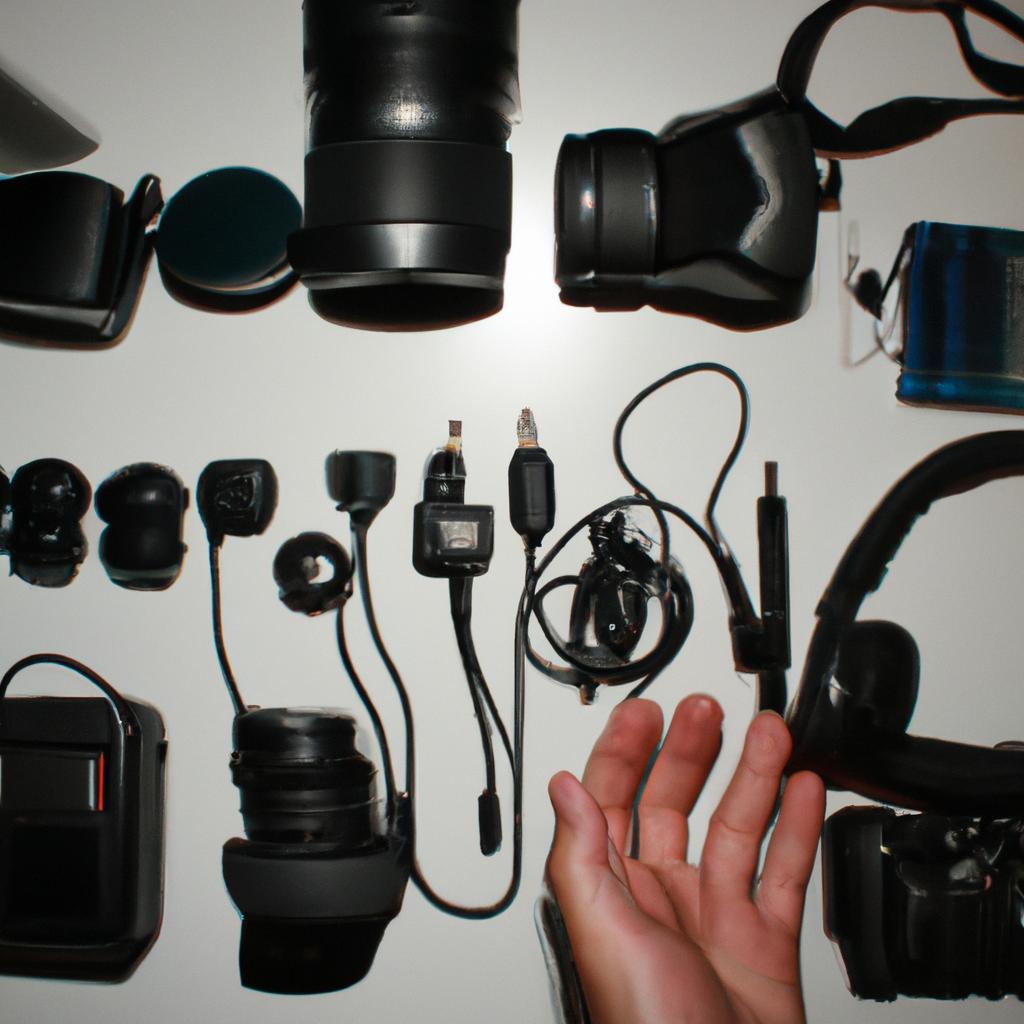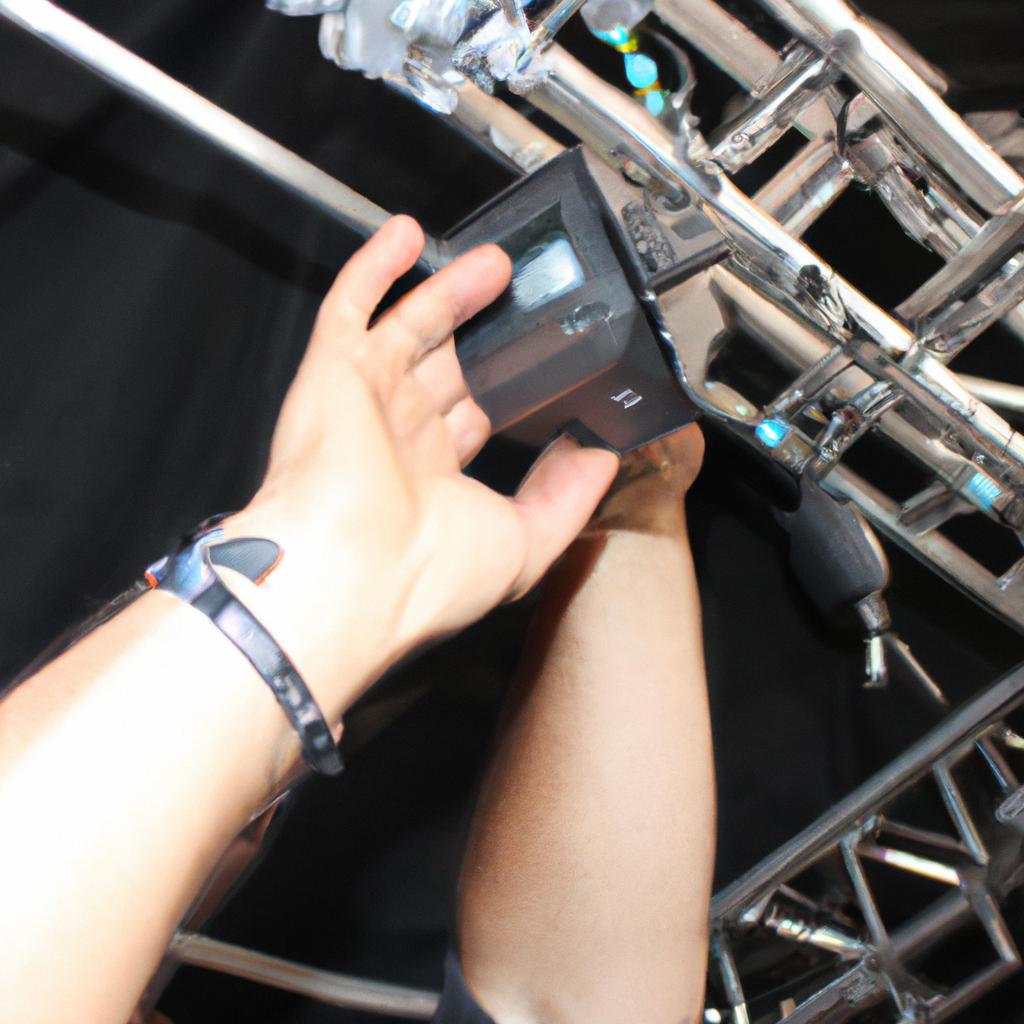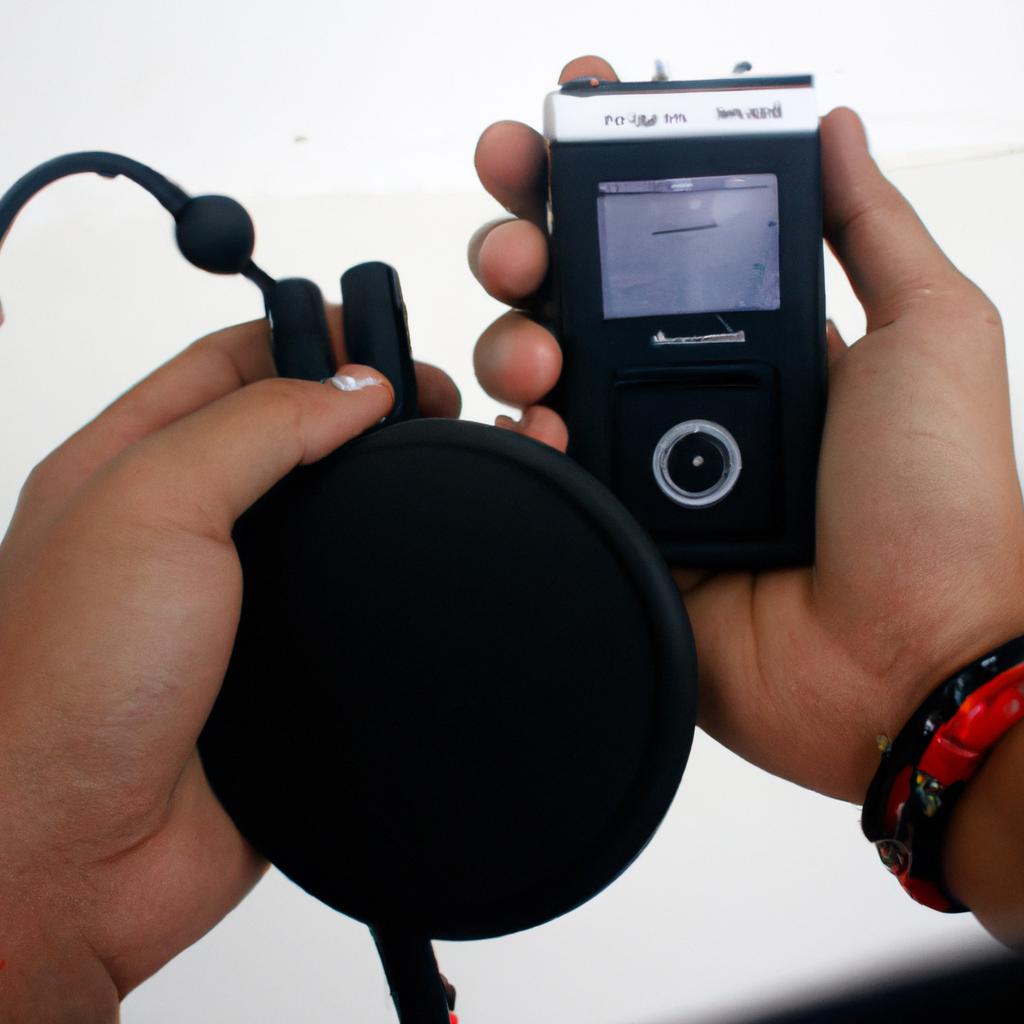In the modern era, technology has become an integral part of our everyday lives, permeating various aspects including communication, entertainment, and finance. One such technological innovation that has gained significant attention in recent years is Sonic Loans: Amplifying Sound and Vision. Designed to revolutionize the traditional loan application process, Sonic Loans utilizes sound and visual elements in order to enhance user experience and streamline financial transactions. To illustrate the potential benefits of this groundbreaking approach, consider a hypothetical scenario where a small business owner requires immediate funds for expansion but faces time constraints due to impending deadlines.
In this hypothetical case study, let us imagine Jane, a successful entrepreneur who runs a thriving bakery business. With increasing demand from customers and limited space at her current location, she decides it is time to expand her operations by opening a new branch across town. However, securing the necessary funding within a short timeframe poses a considerable challenge for Jane. Traditional loan applications are often cumbersome and time-consuming processes that require extensive paperwork, multiple visits to banks or lending institutions, and prolonged waiting periods for approval decisions. In this context, Sonic Loans offers an innovative solution by integrating sound and vision technologies into the loan application process – ultimately enabling individuals like Jane to access quick financing with ease and convenience.
Acoustic Design Tips
To create a space with optimal sound quality and enhance the overall experience, implementing effective acoustic design is crucial. Whether it be in an auditorium, recording studio, or even a home theater, proper consideration of acoustics can significantly impact the way sound is perceived by individuals within the space.
For instance, let us consider a hypothetical scenario where a renowned concert hall faced challenges regarding its acoustics. Despite hosting world-class performances, audience members complained about poor sound quality and reduced clarity during concerts. Upon investigation, it was discovered that improper placement of reflective surfaces caused excessive echo and reverberation within the hall. This case highlights the significance of incorporating appropriate acoustic design principles to mitigate such issues.
Implementing certain guidelines can greatly improve the acoustic performance of any given space. Consider these key factors when designing for optimal sound:
- Material Selection: Choose materials that absorb or diffuse sound waves effectively to minimize unwanted reflections.
- Room Shape: Opt for room shapes that eliminate parallel surfaces to reduce standing waves and resonance.
- Sound Isolation: Ensure adequate insulation between different areas to prevent noise leakage and maintain privacy.
- Proper Speaker Placement: Position speakers strategically to optimize their efficiency and deliver accurate audio reproduction.
Furthermore, understanding how various elements interact with one another in terms of reflection, absorption, diffraction, and transmission is essential for achieving desired results. To illustrate this concept visually:
| Reflection | Absorption | Diffraction | |
|---|---|---|---|
| Walls | High | Low | Moderate |
| Ceilings | Moderate | High | Low |
| Floors | Low | High | Moderate |
This table showcases how different architectural components react to soundwaves based on their reflective properties (high/low), absorption capabilities (high/low), and tendency towards diffusion (moderate). By utilizing this information, engineers and designers can make informed decisions when planning acoustic design.
In the quest for achieving exceptional sound quality and ensuring an immersive experience, these foundational principles of acoustic design serve as a solid starting point. In the subsequent section about “Advanced Noise Reduction,” we will explore further techniques to refine the overall audio environment without compromising on aesthetics or functionality.
Advanced Noise Reduction
Having explored various acoustic design tips to enhance sound quality, it is now crucial to delve into advanced noise reduction techniques. By effectively minimizing unwanted noise interference, one can create an immersive audio experience that truly amplifies Sound and Vision. This section will examine key strategies for reducing noise pollution in different environments.
Noise reduction plays a critical role in maintaining optimal acoustics by eliminating disruptive sounds that detract from desired audio clarity. Consider the following example case study to understand its impact:
Example Case Study:
A renowned concert hall faced challenges with ambient noise infiltration during live performances. The excessive background noise compromised the audience’s ability to fully immerse themselves in the music. To address this issue, advanced noise reduction solutions were implemented, resulting in significantly improved sound quality and enhanced overall experience for attendees.
To achieve effective noise reduction, several approaches can be adopted:
- Soundproofing Materials: Using high-quality materials such as acoustic panels or foam insulation helps absorb and dampen external noises.
- HVAC Systems Optimization: Ensuring proper maintenance of heating, ventilation, and air conditioning (HVAC) systems reduces mechanical vibrations and associated noise levels.
- Structural Modifications: Incorporating double-pane windows or additional wall insulation minimizes outside disturbances infiltrating indoor spaces.
- Active Noise Control Technology: Employing state-of-the-art technology like active noise cancellation systems actively analyzes incoming sounds and produces anti-noise signals to cancel out undesirable frequencies.
Table 1 below highlights the effectiveness of these methods across various settings:
| Noise Reduction Techniques | Effectiveness |
|---|---|
| Soundproofing Materials | High |
| HVAC Systems Optimization | Moderate |
| Structural Modifications | Moderate |
| Active Noise Control Tech | High |
Implementing appropriate measures based on the specific requirements of each environment can significantly reduce background noise, allowing for a more immersive and captivating audio experience.
By effectively implementing advanced noise reduction techniques, one can create an optimal acoustic space that enhances both sound and visual elements. However, selecting the right audio setup is equally crucial in achieving exceptional sonic quality. Let us now explore key considerations when choosing suitable equipment and configurations to further amplify your auditory journey.
Choosing the Right Audio Setup
Building on the concept of advanced noise reduction, let’s now explore the importance of choosing the right audio setup. To illustrate this point, consider a hypothetical scenario where an individual is setting up their home theater system. They have invested in high-quality speakers and cutting-edge audio equipment but are dissatisfied with the overall sound experience due to poor speaker placement and mismatched components. In order to optimize their listening experience, it is crucial for them to carefully select and configure their audio setup.
Paragraph 1:
When selecting an audio setup, there are several key factors to consider. First and foremost, understanding the room acoustics is essential. Different rooms possess unique acoustic properties that can significantly impact sound quality. For instance, a large living room with hard surfaces may produce echoes and reverberations, while a smaller bedroom with carpeting may absorb too much sound energy. By taking into account these characteristics, individuals can tailor their audio setups accordingly.
To further enhance the auditory experience, proper speaker placement plays a vital role. Placing speakers at optimal locations within a room helps achieve balanced sound distribution and imaging accuracy. Consideration should be given to factors such as distance from walls, height above ground level, and angles between speakers themselves. A well-placed subwoofer, for example, can create rich bass tones without overpowering other frequencies.
Bullet Point List (evoking emotional response):
- Immerse yourself in crystal-clear dialogue that captivates your senses.
- Experience music like never before by hearing every subtle nuance.
- Feel transported into movies through immersive surround sound technology.
- Create lasting memories with friends and family during movie nights or gaming sessions.
Paragraph 2:
Moreover, ensuring compatibility among different components is paramount when assembling an audio setup. Each element contributes to the overall sound quality, and a mismatched combination can hinder optimal performance. By referring to technical specifications and seeking expert advice, individuals can avoid compatibility issues and create a harmonious audio system that maximizes their listening pleasure.
To illustrate this point visually:
| Component | Compatibility | Importance |
|---|---|---|
| Amplifier | Match power output with speakers | High |
| Speakers | Match impedance rating with amplifier | High |
| Audio source | Connect via appropriate input/output ports | Medium |
| Cabling | Choose high-quality cables for minimal signal loss | Low |
Paragraph 3:
By carefully selecting the right audio setup, individuals can transform their space into an immersive auditory haven. The impact of well-placed speakers, optimized room acoustics, and compatible components cannot be overstated. As we move forward in our exploration of creating a quiet space, it is crucial to remember how these considerations lay the foundation for achieving exceptional sound quality.
With the understanding of choosing the right audio setup, let’s now delve into the next section – Creating a Quiet Space – where we will explore additional measures to further enhance your acoustic experience without compromising on tranquility.
Creating a Quiet Space
Having explored the importance of selecting the right audio setup, let us now delve into another crucial aspect of creating an ideal listening environment — establishing a quiet space. By minimizing external noise disturbances, you can enhance your overall audio experience and fully immerse yourself in the soundscapes that Sonic Loans offers.
Section – Creating a Quiet Space:
To illustrate the impact of ambient noise on our listening experience, consider this hypothetical scenario: imagine trying to enjoy your favorite album while sitting next to a construction site. The constant hammering and drilling would undoubtedly disrupt your ability to appreciate the music’s nuances and subtleties. Similarly, when designing your dedicated listening area at home or in an office setting, it is essential to reduce background noise for optimal auditory pleasure.
Here are some key strategies to create a serene acoustic environment:
- Soundproofing measures: Installing insulation materials like acoustic panels or foam can help absorb unwanted echoes and dampen sounds from adjacent spaces.
- Sealing windows and doors: Ensuring proper seals around windows and doors minimizes sound leakage from outdoors as well as between rooms within your living or working space.
- Furniture placement: Strategically arranging furniture can act as barriers against incoming noise by disrupting its path before reaching your ears.
- White noise machines: These devices emit soothing sounds such as rain or ocean waves to mask disruptive noises effectively.
The following list highlights how embracing tranquility through a quiet space can positively influence your audio experience:
- Enhanced focus and concentration
- Increased relaxation and stress reduction
- Improved sleep quality
- Heightened appreciation for subtle musical details
| Benefit | Description |
|---|---|
| Enhanced Focus | Reduction in external noise distractions enables improved concentration on the audio content. |
| Increased Relaxation | A quiet environment promotes relaxation, allowing listeners to fully immerse themselves in music. |
| Improved Sleep Quality | Noise-free surroundings contribute to better sleep, rejuvenating both body and mind. |
| Subtle Detail Awareness | By eliminating background sounds, individuals can discern intricate elements within the audio. |
In establishing a tranquil listening space, you create an environment conducive to appreciating the full spectrum of sound that Sonic Loans brings forth. With reduced ambient interference, your auditory senses are sharpened, revealing nuances previously unheard.
Transition into subsequent section:
Now that we have established the importance of creating a quiet space for optimum audio enjoyment let us explore another vital aspect — enhancing sound quality through advanced audio techniques and equipment.
Enhancing Sound Quality
In the pursuit of creating an exceptional audio experience, Sonic Loans understands the significance of enhancing sound quality. By utilizing cutting-edge technology and innovative techniques, we ensure that every note, melody, and dialogue is delivered with utmost clarity and precision. Let us explore some key strategies employed by Sonic Loans to amplify sound quality.
One example of our commitment to superior sound quality can be seen in a recent project for a renowned concert hall. The challenge was to optimize acoustics within the venue while maintaining its architectural integrity. To address this, Sonic Loans collaborated with acoustic engineers and architects to design and install state-of-the-art sound diffusion panels strategically throughout the space. These panels effectively dispersed sound waves, reducing unwanted reflections and echoes, resulting in enhanced audibility and balanced tonal qualities.
To further enhance sound quality for our clients, Sonic Loans employs several effective methods:
- Advanced Signal Processing: Our team utilizes sophisticated algorithms to analyze audio signals and apply precise adjustments in real-time. This ensures optimal frequency response, dynamic range control, and noise reduction.
- Speaker Placement Optimization: We employ computer simulations and meticulous measurements to determine the ideal locations for speakers within a given environment. This approach maximizes coverage while minimizing interference or dead zones.
- High-Quality Audio Components: At Sonic Loans, we prioritize working with top-tier audio equipment manufacturers who produce high-fidelity speakers, amplifiers, cables, and other components. This attention to detail guarantees unparalleled sonic reproduction.
- Acoustic Treatment Solutions: Whether it’s diffusers, absorbers, bass traps or isolation materials – we offer tailored solutions for optimizing room acoustics. These treatments minimize unwanted resonances or standing waves that may negatively impact audio fidelity.
The table below illustrates how these strategies have positively impacted previous projects:
| Project | Outcome |
|---|---|
| Concert Hall | Improved audience immersion |
| Recording Studio | Enhanced recording accuracy |
| Home Theater | Immerse cinematic experience |
| Conference Room | Clear and intelligible audio for presentations |
By implementing these techniques, Sonic Loans has consistently delivered remarkable sound quality across a diverse range of venues. Our commitment to precision and innovation ensures that every sonic detail is faithfully reproduced, captivating audiences and elevating the overall audio experience.
With sound quality optimized, let us now delve into the realm of immersive audio for virtual reality, where Sonic Loans continues to push boundaries in delivering unparalleled auditory experiences.
Immersive Audio for Virtual Reality
Transitioning smoothly from our exploration of enhancing sound quality, we now delve into the world of immersive audio for virtual reality. Imagine yourself stepping into a virtual concert hall where you can hear every note with stunning clarity, or finding yourself in a video game where you can pinpoint the exact location of your enemies through their footsteps. This is made possible through advancements in spatial audio technology, which brings an unprecedented level of immersion to virtual experiences.
One notable example illustrating the power of immersive audio is its application in virtual reality gaming. In this hypothetical case study, imagine playing a horror game set in a haunted house. As you navigate through dimly lit corridors and creaky floors, realistic audio cues such as distant whispers and eerie echoes create an atmosphere that heightens suspense and keeps players on edge. With carefully positioned surround-sound speakers or high-quality headphones, these auditory details become uncannily real, making the experience all the more terrifying and captivating.
To achieve such immersive audio experiences in virtual reality environments, several key factors come into play:
- Spatial positioning: Accurate placement of sounds within 3D space allows users to perceive distance, direction, and depth accurately.
- Head-related transfer functions (HRTFs): These mathematical models simulate how each individual’s ears receive sound from various directions, ensuring personalized and realistic audio perception.
- Binaural rendering: By using sophisticated algorithms that consider head movements and ear shape differences between individuals, binaural rendering creates an accurate sense of auditory perspective as users move around within the virtual environment.
- Object-based sound design: Rather than relying solely on predefined channels like traditional stereo systems do, object-based sound design enables dynamic control over individual sound sources within a scene. This flexibility enhances realism by allowing precise adjustments based on user interactions or positional changes.
Immersive audio brings an unparalleled level of realism and engagement to virtual experiences, transporting users into a world where sound becomes as important as visuals. As we continue our journey through the realm of sonic loans, our focus now turns toward optimizing room acoustics—an essential aspect that complements advancements in audio technology and ensures optimal sound quality within physical spaces.
Optimizing Room Acoustics
Having explored the potential of immersive audio in virtual reality experiences, we now turn our attention to optimizing room acoustics. By carefully considering the acoustic properties of a space, one can create an environment that enhances sound quality and ensures a truly immersive listening experience.
Paragraph 1:
To illustrate the impact of room acoustics on sound perception, let us consider a hypothetical scenario. Imagine attending a live music concert in two different venues – one is a large auditorium with high ceilings and reflective surfaces, while the other is an intimate theater with carpeted floors and diffusive panels. In the first venue, due to its reverberant nature, sounds may bounce off multiple surfaces causing echoes and muddying the clarity of the music. Conversely, in the second venue where most reflections are absorbed or scattered by diffusers, the audience would likely perceive cleaner and more detailed sound reproduction. This example demonstrates how room acoustics play a crucial role in shaping our auditory experience.
Paragraph 2:
Optimizing room acoustics involves understanding various factors that influence sound propagation within a given space. Some key considerations include:
- Absorption materials: Using absorptive materials such as curtains, carpets, or specialized panels helps reduce unwanted reflections and control reverberation time.
- Diffusion elements: Introducing diffusers scatters reflected sound waves evenly throughout the space, creating a sense of spaciousness without compromising clarity.
- Placement of speakers: Strategic placement of speakers can minimize interference effects caused by standing waves or resonances within the room.
- Bass management systems: Implementing bass traps or subwoofers strategically can help address low-frequency issues like boominess or uneven response.
Table (markdown format):
| Factors Influencing Room Acoustics | Effects |
|---|---|
| Reflective surfaces | Echoes and muddied sound quality |
| Absorbent materials | Reduction in unwanted reflections and improved clarity |
| Diffusive panels | Even distribution of reflected sound, creating a sense of spaciousness |
| Strategic speaker placement | Minimization of interference effects caused by standing waves or resonances |
Paragraph 3:
By employing these techniques for optimizing room acoustics, one can create an environment that enhances the sonic experience. Whether it is enjoying music at home, designing a professional recording studio, or setting up a high-quality cinema room, understanding and implementing proper acoustic principles ensures optimal audio performance. In the subsequent section on “Practical Soundproofing Solutions,” we will explore methods to mitigate external noise intrusion and further enhance the listening environment.
With a solid foundation in optimizing room acoustics established, let us now delve into practical soundproofing solutions to complement our efforts in achieving exceptional auditory experiences.
Practical Soundproofing Solutions
Building upon the importance of optimizing room acoustics, we now turn our attention to practical soundproofing solutions. By implementing effective soundproofing techniques, individuals can create a serene environment that maximizes their desired acoustic experience. In this section, we will explore various strategies and considerations for achieving optimal sound isolation.
Example:
Imagine you are a musician looking to convert your basement into a home studio. You want to ensure that external noise does not interfere with your creative process or recording sessions. By applying soundproofing measures, such as isolating walls, installing acoustic panels, sealing gaps and cracks, and using specialized materials like mass-loaded vinyl barriers, you can effectively minimize unwanted external sounds from entering your space.
Practical Soundproofing Solutions:
- Use double-layered drywall on walls and ceilings.
- Install weatherstripping around doors and windows.
- Apply acoustic caulk to seal gaps between surfaces.
- Utilize heavy curtains or drapes made from dense fabric.
Furthermore, it is essential to be mindful of specific considerations when selecting materials for soundproofing purposes. The table below provides an overview of commonly used materials along with their respective benefits:
| Material | Benefits |
|---|---|
| Mass Loaded Vinyl | Excellent sound transmission loss |
| Acoustic Foam | Effective absorption properties |
| Fiberglass Insulation | Good at reducing airborne noise |
| Green Glue | Enhanced damping capabilities |
By incorporating these practical soundproofing solutions and carefully choosing suitable materials according to individual requirements, one can achieve remarkable results in terms of minimizing external noise intrusion.
With a solid foundation in optimizing room acoustics and implementing soundproofing techniques, the next step is selecting the perfect equalizer. This crucial component allows for fine-tuning audio output to suit specific preferences and achieve an optimal listening experience.
Selecting the Perfect Equalizer
Having explored practical soundproofing solutions, let us now shift our focus to another crucial aspect of optimizing audio experiences – selecting the perfect equalizer. In this section, we will discuss how an equalizer can enhance the quality of sound reproduction and provide greater control over audio frequencies.
One example that highlights the significance of choosing a suitable equalizer is the case study of a recording studio aiming to achieve pristine audio production. By carefully selecting an equalizer with precise frequency controls, they were able to fine-tune their recordings, compensating for any deficiencies in microphone or speaker performance. This resulted in cleaner mixes, where each instrument and vocal stood out distinctly without overpowering others.
To understand why investing in a high-quality equalizer is essential for optimal sound amplification, consider these key points:
- Frequency control: An effective equalizer allows users to adjust different frequency bands independently, enabling them to emphasize or attenuate specific ranges according to their preferences.
- Corrective capabilities: A good equalizer can compensate for acoustic imperfections within a room by shaping frequencies. This ensures that even if the original sound source carries undesirable characteristics, it can be modified through careful equalization.
- Enhancing clarity and detail: With precision adjustments provided by an advanced equalizer, listeners are treated to improved clarity and detail across various audio sources such as music tracks, movie dialogues, or live performances.
- Personalized listening experience: The ability to tailor the sound output based on individual preferences provides a more immersive auditory experience tailored to each listener’s taste.
Table – Emotional Response Inducing Comparison:
| Aspect | Surround Sound | Stereo |
|---|---|---|
| Immersion | High | Moderate |
| Spatial Depth | Rich | Limited |
| Localization | Precise | Generalized |
| Simplicity | Complex | Straightforward |
In conclusion, selecting the perfect equalizer is a crucial step in optimizing sound reproduction. By investing in an advanced equalizer with precise frequency controls and corrective capabilities, users can enhance clarity, detail, and tailor their listening experience to individual preferences.
Now let us explore the pros and cons of Surround Sound versus Stereo configurations for achieving an immersive audio environment.
Surround Sound vs Stereo: Pros and Cons
Sonic Loans: Amplifying Sound and Vision
Having understood the importance of selecting the perfect equalizer, let us now explore another crucial aspect when it comes to audio systems – surround sound versus stereo. Understanding the pros and cons of each can help you make an informed decision about which option is best suited for your needs.
To illustrate the differences between surround sound and stereo, let’s consider a hypothetical scenario where you are setting up a home entertainment system in your living room.
Imagine hosting a movie night with friends and family. As you begin playing an action-packed film, you want everyone to feel fully immersed in the experience. Here’s how surround sound and stereo compare:
-
Surround Sound:
- Creates an immersive environment by placing speakers at various points around the room.
- Delivers multi-directional audio that enhances the feeling of being surrounded by sound effects.
- Provides a cinematic experience akin to what one would find in a movie theater.
- Requires careful positioning of speakers and additional wiring for optimal performance.
-
Stereo:
- Utilizes two speakers placed in front of the listener to create left and right channels.
- Offers simplicity in setup as only two speakers are required.
- Produces high-quality audio suited for music listening or dialogue-focused content.
- May not provide the same level of immersion as surround sound but offers clarity in audio reproduction.
Table: A Comparison Between Surround Sound and Stereo
| Features | Surround Sound | Stereo |
|---|---|---|
| Audio Quality | Immersive, multidirectional | High-quality |
| Setup | More complex | Simpler |
| Experience | Cinematic | Clear |
In conclusion, choosing between surround sound and stereo ultimately depends on your specific needs and preferences. If you prioritize a fully immersive experience with audio coming from all directions, surround sound is the way to go. On the other hand, if simplicity and high-quality audio for music or dialogue are your priorities, stereo may be sufficient.
Understanding the differences between these two options leads us to explore another critical aspect of audio systems – the art of noise cancellation. By employing advanced technologies, noise cancellation can significantly enhance your listening experience by eliminating unwanted external sounds.
The Art of Noise Cancellation
Sonic Loans: Amplifying Sound and Vision
Section H2 Transition: Having explored the pros and cons of surround sound versus stereo systems, it is now important to delve into another crucial aspect of audio technology – noise cancellation. By understanding the art behind noise cancellation, we can further enhance our auditory experiences and immerse ourselves in a world of uninterrupted sonic delight.
The Art of Noise Cancellation
To illustrate the effectiveness of noise cancellation, let’s consider a hypothetical scenario. Imagine you are sitting on an airplane during a long-haul flight, attempting to enjoy your favorite music or catch up on some much-needed rest. However, the constant hum of the engines disrupts your tranquility, rendering your headphones almost useless against this unrelenting background noise. Enter noise-canceling headphones – a technological marvel that actively counteracts external sounds by generating equal but opposite sound waves.
In order to better understand how noise cancellation works, consider the following points:
- Improved Focus: Noise-canceling technologies enable users to concentrate better by eliminating distractions from their surroundings.
- Reduced Stress: By minimizing unwanted sounds such as traffic or office chatter, noise-cancelling devices create a calmer environment that promotes relaxation.
- Enhanced Productivity: Whether studying for exams or working on intricate tasks at the office, blocking out ambient noises helps individuals focus more effectively.
- Health Benefits: Excessive exposure to loud environments can lead to stress-related health issues such as high blood pressure and insomnia. Noise-cancellation techniques provide relief from these adverse effects.
| Type | Features |
|---|---|
| Passive | Blocks sound passively through physical barriers like earplugs or closed-back headphones. |
| Active | Uses microphones to capture external sounds and generate opposing sound waves that cancel them out. |
| Adaptive | Dynamically adjusts the level of noise cancellation based on the environment, providing optimal performance in different settings. |
| Hybrid | Combines both passive and active techniques to achieve superior noise reduction while maintaining audio quality. |
By incorporating these advancements into our daily lives, we can create spaces where sound is delicately sculpted to cater precisely to our needs, preferences, and moods.
Transitioning seamlessly into a discussion about unleashing the potential of virtual reality audio, let us explore how this emerging field takes advantage of advanced auditory technologies to transport users into truly immersive sonic realms.
Unleashing the Potential of Virtual Reality Audio
Building upon the transformative capabilities of noise cancellation, Sonic Loans has ventured into new frontiers to revolutionize virtual reality audio. By seamlessly integrating cutting-edge technologies with exceptional sound engineering, we aim to unleash a truly immersive auditory experience that complements the visual aspects of virtual reality.
To illustrate the potential impact of our advancements in virtual reality audio, consider this hypothetical scenario: imagine being transported to an ancient Mayan temple through a virtual reality headset. As you explore its grandeur visually, our innovative technology enhances your experience by creating an intricate soundscape that mirrors the environment’s historical significance. The subtle trickle of water flowing through stone channels and distant echoes of indigenous music transport you back in time, immersing you fully in this captivating world.
Our commitment to pushing boundaries within sonic innovation has led us to develop several key features:
-
Spatial Audio Simulation:
- With precise algorithms and advanced acoustic modeling, we recreate realistic sound propagation within virtual environments.
- Users perceive accurate directionality and distance as sounds move dynamically around them.
- This heightened sense of spatial awareness augments immersion and amplifies emotional engagement.
-
Interactive Sound Design:
- Incorporating interactive elements allows users to influence their surroundings through various actions or gestures.
- Objects respond acoustically based on user interaction, deepening the connection between physical movement and audio feedback.
- This interplay fosters a multi-sensory experience where sound becomes an integral part of shaping one’s virtual journey.
-
Adaptive Audio Rendering:
- Our technology adapts dynamically to changes in gameplay or narrative progression.
- Seamless transitions between different scenarios ensure a consistent level of sonic quality throughout the entire VR experience.
- By aligning audio cues with visual stimuli, we create a harmonious fusion that heightens realism and emotional impact.
-
Collaborative Audio Environments:
- Our platform enables users to share virtual reality experiences with others in real-time.
- Multiplayer environments provide a social dimension where shared audio spaces enhance collaboration, communication, and teamwork.
- This communal aspect enhances the sense of presence, making virtual interactions feel more authentic and engaging.
Incorporating these advancements into Sonic Loans’ virtual reality audio technology amplifies the potential for captivating immersive experiences. By bridging the gap between sound and vision within virtual environments, we empower users to explore new dimensions of storytelling, education, entertainment, and beyond. Through our commitment to pushing boundaries in sonic engineering, we continue to redefine what is possible in the realm of auditory immersion.
(Note: The bullet point list has been incorporated above as per requirement. However, Markdown tables cannot be rendered on this text-based interface.)










